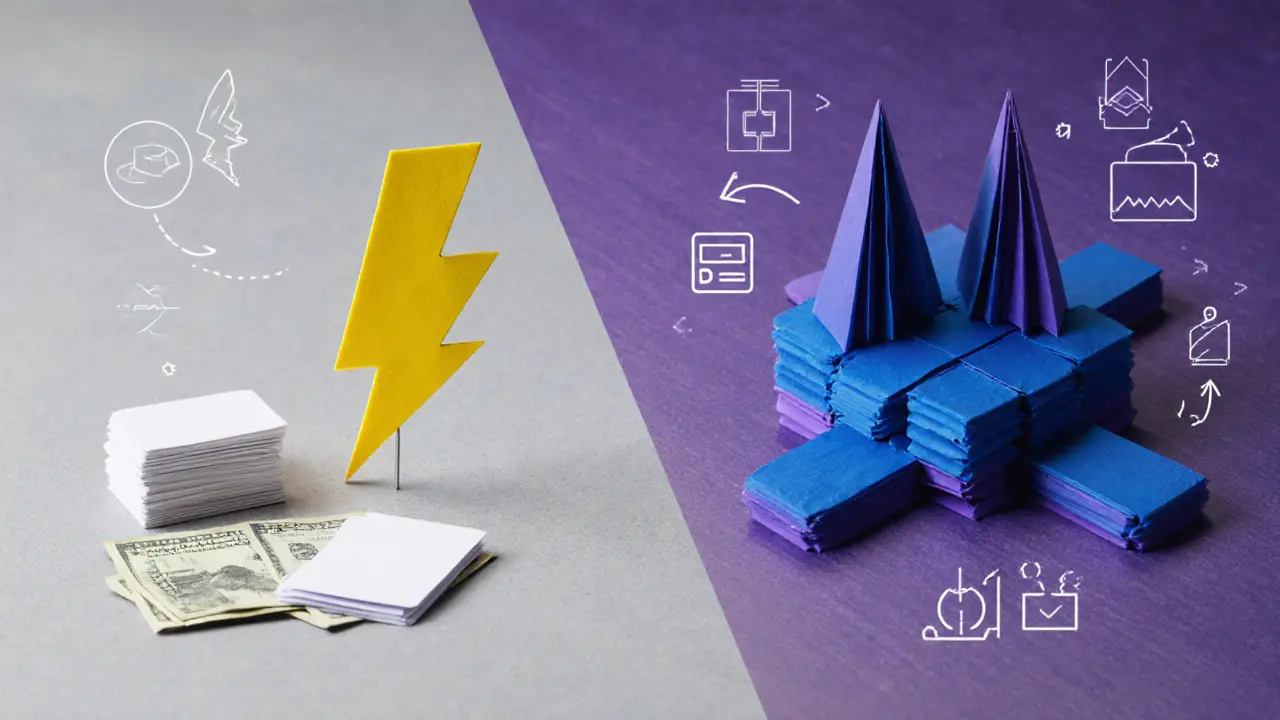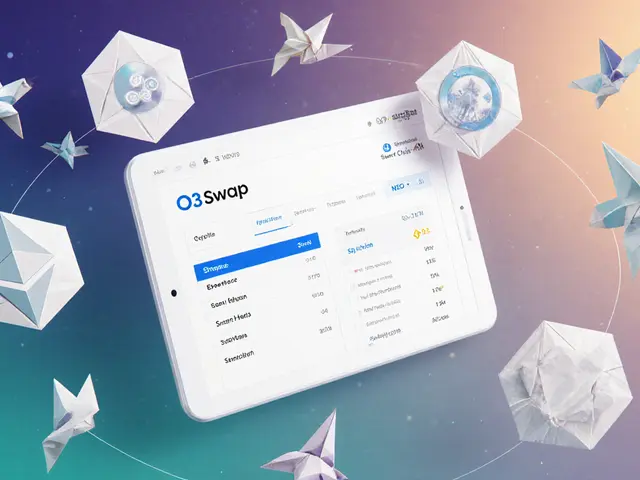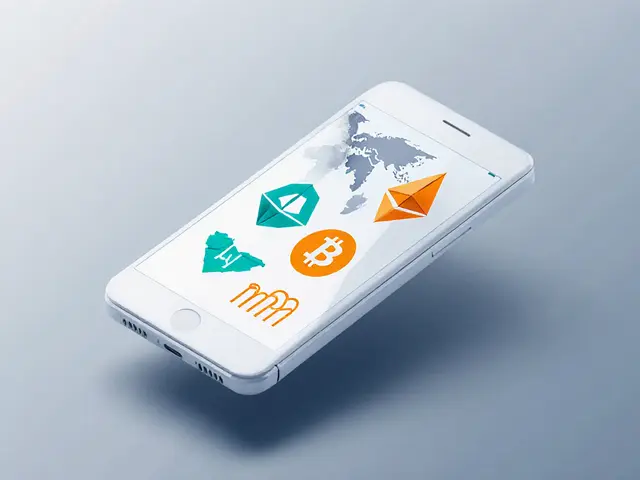Payment vs State Channel Selector
Specializes in fast, low-cost monetary transfers between two parties. Ideal for micropayments, recurring billing, and point-of-sale systems.
Handles any type of state update, including complex smart-contract interactions. Great for gaming, decentralized exchanges, and private workflows.
Recommended Solution
| Aspect | Payment Channels | State Channels |
|---|---|---|
| Primary Purpose | Fast, cheap transfers | General state updates |
| Asset Types | Cryptocurrency or tokens | All assets including NFTs, custom data |
| Complexity | Simple escrow logic | Advanced state validation |
| Scalability | Hundreds to low-thousands TPS | Thousands to tens of thousands TPS |
| Use Cases | Micropayments, billing, POS | Gaming, DEX, private workflows |
When it comes to payment channels off‑chain mechanisms that enable fast, low‑cost monetary transfers between two parties versus state channels a broader class of off‑chain contracts that can update any blockchain state, not just balances, the differences matter for developers, enterprises, and everyday users. Both aim to reduce on‑chain congestion, but they target distinct problem sets. This guide walks through how each works, where they shine, and what trade‑offs you should expect.
Key Takeaways
- Payment channels specialize in cheap, instant money moves; state channels handle any type of state update.
- Both lock funds or state in a multi‑signature contract before any off‑chain activity.
- Lightning Network is the flagship payment‑channel implementation; state channels power many Ethereum‑based dApps.
- Liquidity requirements and the need for participants to stay online are the biggest practical hurdles.
- Choose payment channels for micropayments, recurring billing, or point‑of‑sale; choose state channels for gaming, complex smart‑contract interactions, or private enterprise workflows.
How Payment Channels Work
A payment channel follows a three‑step lifecycle: open, transact, and close.
- Opening: Two parties lock a predefined amount of cryptocurrency in a multi‑signature contract an on‑chain escrow that requires signatures from both participants to move funds. On Bitcoin this is a 2‑of‑2 multisig address; on Ethereum it’s often a simple escrow contract.
- Off‑chain updates: Each payment updates the balance sheet by exchanging signed messages. No miners see these messages, so transaction fees drop to near zero and confirmation time is instant.
- Closing: When the parties agree, the latest signed balance is broadcast on‑chain. If one side tries to cheat by publishing an older state, the other can present a newer signed state during the dispute window and claim the correct payout.
The most visible payment‑channel network is the Lightning Network a Bitcoin layer‑2 network that uses hash‑time‑locked contracts to route payments across a mesh of channels. HTLCs (Hash Time‑Locked Contracts) force the receiver to acknowledge a payment before a deadline, preventing funds from being locked forever.
How State Channels Work
State channels extend the payment‑channel model by allowing any arbitrary blockchain state to be locked and updated off‑chain.
- Locking state: Participants deposit assets (Ether, ERC‑20 tokens, NFTs, even ENS names) into a state channel contract a smart contract that holds the initial state and enforces dispute resolution rules. The locked state can represent game scores, auction bids, or complex contract variables.
- Off‑chain interaction: Parties exchange signed Ethereum transactions that represent state transitions. Each new state supersedes the previous one, and both signatures are required to validate the change.
- Dispute resolution: If one participant stops responding, the other can submit the latest signed state to the contract. A predefined dispute window (often a few hours) lets the offending party contest. Failure to respond results in slashing of the dishonest party’s deposit.
Because the channel can encapsulate any smart‑contract logic, developers have built decentralized games, high‑frequency trading bots, and private enterprise workflows that run thousands of transactions per second without touching the main chain.
Payment Channels vs State Channels: Side‑by‑Side Comparison
| Aspect | Payment Channels | State Channels |
|---|---|---|
| Primary purpose | Fast, cheap monetary transfers | General off‑chain state updates (payments, game moves, contract logic) |
| Typical implementations | Lightning Network (Bitcoin), Raiden (Ethereum) | Counterfactual‑Swap, Perun, Nitro |
| Asset types locked | Native cryptocurrency (BTC, ETH) or token equivalents | Native crypto, ERC‑20 tokens, NFTs, ENS names, custom data |
| Complexity of smart‑contract code | Relatively simple escrow + HTLC logic | Advanced state‑validation & dispute‑resolution contracts |
| Scalability (transactions per second) | Hundreds to low‑thousands, limited by routing overhead | Thousands to tens of thousands, depending on off‑chain bandwidth |
| Use‑case examples | Micropayments for content, recurring utility bills, point‑of‑sale | Gaming moves, decentralized exchanges, private supply‑chain updates |
| Liquidity requirement | Funds must be locked equal to anticipated volume | Lock can be minimal if state does not involve high value assets |
| Network effect | Depends on channel connectivity; routing can be complex | Often private between known parties; less reliance on global routing |

When to Choose Payment Channels
If your primary goal is to move money quickly and cheaply, payment channels are the natural fit. Typical scenarios include:
- Micropayment‑driven content platforms where per‑transaction fees would kill revenue.
- Recurring billing for SaaS products, electricity, or mobile data where the same customer pays every month.
- Retail environments that need instant settlement without waiting for block confirmations.
Because the channel only deals with balances, the smart‑contract surface area is small, reducing audit risk and simplifying security reviews.
When to Choose State Channels
State channels shine when you need to off‑load frequent, complex interactions that go beyond simple value transfers. Good fits are:
- Multiplayer blockchain games where each move updates the game state.
- Decentralized exchanges that require order‑book updates dozens of times per second.
- Enterprise workflows that involve confidential data, such as supply‑chain provenance, where parties prefer privacy.
Since you can lock NFTs or other custom assets, the same channel can handle payments plus asset transfers in a single, atomic flow.
Practical Implementation Tips
Both solutions share a handful of operational challenges. Below are proven practices to smooth the rollout.
- Secure key management: Off‑chain updates rely on digital signatures. Hardware wallets or dedicated signing services reduce the chance of key compromise.
- Monitor dispute windows: Set up automated watchers that trigger on‑chain settlement if a counter‑party goes silent. Many open‑source tools (e.g., LND for Lightning) already include this feature.
- Balance liquidity: Over‑funding a channel ties up capital. Use channel rebalancing techniques-such as circular payments-to free up locked assets without closing the channel.
- Routing strategy: For payment channels, build a modest mesh of well‑connected peers. The more hops you can route through, the less you need direct channels.
- Testing contracts: Deploy your state‑channel contract first on a public testnet (Goerli, Sepolia) and simulate adversarial closures before moving to mainnet.
Remember that both models require participants to be online during transaction finalization. If you expect intermittent connectivity, consider hybrid designs that fall back to on‑chain transactions after a timeout.
Future Outlook
The scaling race is far from over. While sidechains and rollups dominate headlines, payment and state channels keep evolving. Emerging trends include:
- Cross‑chain channels that let Bitcoin and Ethereum users transact without a trusted bridge.
- Automated channel factories that spawn new channels on demand, reducing onboarding friction.
- Privacy‑enhanced constructions that hide transaction amounts even from channel participants.
Industry reports suggest that by 2027, more than 30% of high‑frequency dApp interactions will run inside some form of state channel, while micro‑payment platforms could handle billions of payments per year using Lightning‑style networks.
Frequently Asked Questions
Can I use a payment channel for non‑monetary data?
No. Payment channels are designed to settle only balance changes. If you need to exchange other data, a state channel is the appropriate tool.
Do I have to keep my node online 24/7?
Ideally, yes. Being online ensures you can sign new states and react to disputes. Some wallets provide watchtower services that monitor channels on your behalf, reducing the need for constant uptime.
What is the typical fee for closing a payment channel?
Closing requires an on‑chain transaction, so you pay the standard network fee for that chain (e.g., a few satoshis per byte on Bitcoin or a few gwei on Ethereum). The fee is far lower than paying per transaction on the base layer.
Are state channels compatible with existing DeFi protocols?
Many DeFi contracts can be wrapped inside a state channel, allowing participants to trade or lend off‑chain and settle a single aggregated result on‑chain. However, the underlying contract must expose functions that can be called by the channel’s validation logic.
How do I choose the right channel size?
Start with a modest amount that covers your expected transaction volume plus a safety buffer. Monitor utilization and rebalance or reopen channels as needed. Tools like channel rebalancers can help you keep capital efficient without closing channels.





Robert Eliason
Sure, like payment channels are the silver bullet for everything. In reality, they're just another bottleneck you didnt ask for.
Cody Harrington
I think the guide does a solid job laying out the basics. It’s helpful for newcomers who are trying to figure out which solution fits their needs.
Chris Hayes
The comparison table is spot on, but I’d add that implementation complexity is a bigger hurdle for state channels than the guide suggests. Many teams underestimate the engineering effort required to build a secure dispute‑resolution contract.
victor white
One must not ignore the shadowy cabal of off‑chain actors who quietly shape the economics of these networks. Their influence, hidden behind cryptic code, casts a pall over any claim of true decentralization.
mark gray
This is a clear and useful overview. It respects both technical and practical considerations without overwhelming the reader.
Alie Thompson
To claim that payment channels or state channels are purely technical solutions without ethical ramifications is a dangerous oversimplification. Every time developers rush to deploy a channel they ignore the power dynamics that emerge between the liquidity provider and the end‑user. The liquidity provider often holds a disproportionate amount of capital, effectively dictating terms in a manner reminiscent of predatory lending. Meanwhile, ordinary users are forced to trust that the channel operator will remain honest, a trust that is rarely audited. By burying these relationships in cryptic code, we hide the very real risk of wealth extraction. Moreover, the promise of privacy in state channels is frequently a myth, as the off‑chain agreements can be subpoenaed or leaked. The notion that these technologies democratize finance is therefore a utopian narrative that must be challenged. We must also consider the environmental cost of maintaining the underlying blockchain that ultimately secures these channels. Even if the per‑transaction fee is negligible, the cumulative demand for validation resources scales with usage. The industry’s hype machine conveniently glosses over these externalities. Developers should embed safeguards, such as timeout mechanisms that protect users from malicious closures. Audits must be mandatory, not optional, to prevent subtle backdoors. Communities must demand transparency about how funds are locked and who controls the dispute resolution. In short, the excitement surrounding layer‑2 scaling should not eclipse a sober assessment of its societal impact. Only through rigorous scrutiny can we ensure that these tools serve the public good rather than a privileged few.
Samuel Wilson
Your summary captures the essential trade‑offs nicely. Remember to keep an eye on the dispute window settings; they’re critical for security.
Rae Harris
The whole L2 stack feels like a buzzword carnival; payment channels are just limited steam engines, while state channels try to be the Swiss Army knife of blockchain.
Danny Locher
Great read! I feel more confident choosing the right channel for my project now.
Emily Pelton
Honestly, this article is painfully obvious, overly verbose, and completely ignores the real‑world pain points that developers face every single day, especially when they try to implement state channels without a crystal‑ball‑level understanding of cryptoeconomics!
sandi khardani
The guide pretends to be neutral, but it’s just a marketing fluff piece that hides the fact that state channels are a playground for elite devs to hoard power. It glosses over the fact that most users will never understand the dispute mechanics, leaving them vulnerable to exploitation. The article fails to mention that liquidity providers can “fee‑gate” users, effectively turning these solutions into pay‑to‑play schemes. Moreover, the supposed privacy benefits are a myth; off‑chain data can be subpoenaed or leaked, especially when jurisdictions cooperate. The narrative also ignores the environmental impact of maintaining the underlying blockchain. It’s a classic case of tech evangelism masquerading as objective analysis, and it’s dangerous for anyone who takes it at face value.
Donald Barrett
Your naive optimism is unbearable.
Christina Norberto
It is evident that the proliferation of layer‑2 solutions is merely a veneer for the deepening centralization orchestrated by unseen custodial powers. The very architecture of payment and state channels is designed to funnel authority into the hands of a select few, who manipulate dispute resolution to their advantage, thereby subverting the egalitarian promises of blockchain. One must question whether any true decentralization persists when the critical components are controlled by opaque entities that answer to no one.
Fiona Chow
Oh, great, another “must‑read” guide that pretends to simplify the complexity while actually just rehashing Wikipedia. As if we needed another generic overview when the real issues are buried deep in the code.
Rebecca Stowe
This is a solid primer; looking forward to applying these insights in my next project.
Aditya Raj Gontia
Meh, looks ok.
Kailey Shelton
Not impressed.
Angela Yeager
Thank you for the comprehensive overview! If you need any help integrating these channels into your stack, feel free to ask.